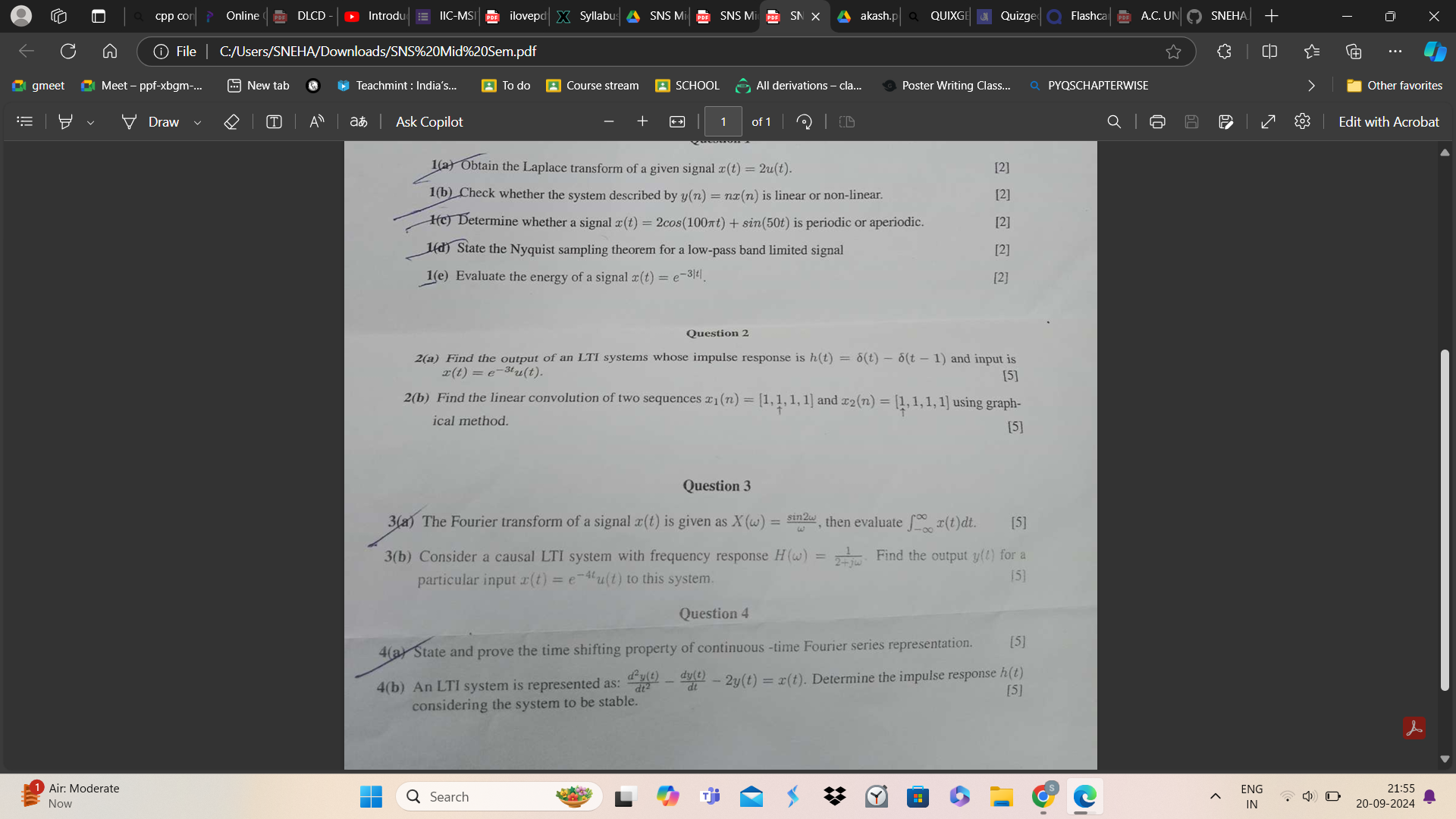1(a) Obtain the Laplace transform of a given signal x(t) = 2u(t). 1(b) Check whether the system described by y(n) = nx(n) is linear or non-linear. 1(c) Determine whether a signal x... 1(a) Obtain the Laplace transform of a given signal x(t) = 2u(t). 1(b) Check whether the system described by y(n) = nx(n) is linear or non-linear. 1(c) Determine whether a signal x(t) = 2cos(100πt) + sin(50t) is periodic or aperiodic. 1(d) State the Nyquist sampling theorem for a low-pass band limited signal. 1(e) Evaluate the energy of a signal x(t) = e^(-3t). 2(a) Find the output of an LTI system whose impulse response is h(t) = δ(t) - δ(t - 1) and input is x(t) = e^(-3t)u(t). 2(b) Find the linear convolution of two sequences z1(n) = [1, 1, 1, 1] and z2(n) = [1, 1, 1, 1] using graphical method. 3(a) The Fourier transform of a signal x(t) is given as X(ω) = sin(2ω)/ω, then evaluate ∫_{-∞}^{∞} x(t) dt. 3(b) Consider a causal LTI system with frequency response H(ω) = 1/(2+jω). Find the output y(t) for a particular input x(t) = e^(-4t)u(t) to this system. 4(a) State and prove the time shifting property of continuous-time Fourier series representation. 4(b) An LTI system is represented as: d^3y(t)/dt^3 - dy(t)/dt - 2y(t) = x(t). Determine the impulse response h(t) considering the system to be stable.

Understand the Problem
The question set includes topics related to Laplace transforms, Fourier transforms, linear convolution, and the properties of LTI systems. It asks for calculations, evaluations, and theoretical explanations related to these subjects in signal processing.
Answer
1. $X(s) = \frac{2}{s}$, 2. Linear, 3. Periodic, 4. $f_s \geq 100 \text{ Hz}$, 5. $E = \frac{1}{6}$.
Answer for screen readers
-
$X(s) = \frac{2}{s}$ for $Re(s) > 0$
-
The system is linear.
-
The signal $x(t)$ is periodic.
-
Minimum sampling frequency $f_s \geq 100 \text{ Hz}$.
-
Energy $E = \frac{1}{6}$.
Steps to Solve
- Obtain the Laplace Transform of $x(t)$
For the signal $x(t) = 2u(t)$, we will use the Laplace transform formula:
$$ X(s) = \int_0^{\infty} x(t) e^{-st} dt $$
Substituting the function:
$$ X(s) = \int_0^{\infty} 2 e^{-st} dt $$
- Evaluate the integral
The integral can be solved as follows:
$$ X(s) = 2 \int_0^{\infty} e^{-st} dt = 2 \left[-\frac{1}{s} e^{-st} \right]_0^{\infty} $$
Evaluating the limits gives:
$$ X(s) = 2 \left[0 + \frac{1}{s}\right] = \frac{2}{s} \text{ for } Re(s) > 0 $$
- Check if the system is linear or non-linear
To check if the system given by $y(n) = nx(n)$ is linear, test for the superposition principle:
Let $x_1(n)$ and $x_2(n)$ be two input sequences. We check:
$$ y_1(n) + y_2(n) = n x_1(n) + n x_2(n) = n(x_1(n) + x_2(n)) $$
Since it holds true for any input, the system is linear.
- Determine periodicity.
For $x(t) = 2\cos(100\pi t) + \sin(50t)$:
The term $2\cos(100\pi t)$ has a period of $T_1 = \frac{2\pi}{100\pi} = \frac{1}{50}$,
The term $\sin(50t)$ has a period of $T_2 = \frac{2\pi}{50} = \frac{\pi}{25}$.
To find the least common multiple (LCM):
$$ \text{lcm}(T_1, T_2) = \text{lcm}\left(\frac{1}{50}, \frac{\pi}{25}\right) = \frac{1}{50} $$
Thus, the overall signal $x(t)$ is periodic.
- Apply the Nyquist Sampling Theorem
The Nyquist theorem states that the sampling frequency must be at least twice the maximum frequency:
$$ f_s \geq 2 \cdot 50 = 100 \text{ Hz} $$
- Evaluate the energy of the signal $x(t) = e^{-3t}u(t)$
The energy $E$ is given by:
$$ E = \int_{-\infty}^{\infty} |x(t)|^2 dt = \int_0^{\infty} (e^{-3t})^2 dt = \int_0^{\infty} e^{-6t} dt $$
Solving this gives:
$$ E = \left[-\frac{1}{6} e^{-6t}\right]_0^{\infty} = \frac{1}{6} $$
-
$X(s) = \frac{2}{s}$ for $Re(s) > 0$
-
The system is linear.
-
The signal $x(t)$ is periodic.
-
Minimum sampling frequency $f_s \geq 100 \text{ Hz}$.
-
Energy $E = \frac{1}{6}$.
More Information
The Laplace transform is a fundamental tool in control systems, allowing the analysis of linear time-invariant (LTI) systems. The periodicity check is essential for determining sampling requirements, while energy evaluation is crucial in communications and signal theory.
Tips
- Forgetting the initial conditions when evaluating integrals for the Laplace transform can lead to incorrect answers.
- Skipping verification steps of linearity can result in concluding that a system is linear or non-linear incorrectly.
- Not checking the units carefully when calculating energy may also lead to confusion.
AI-generated content may contain errors. Please verify critical information